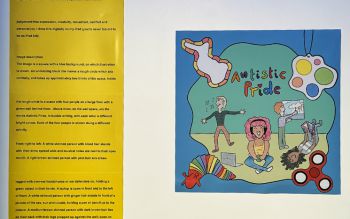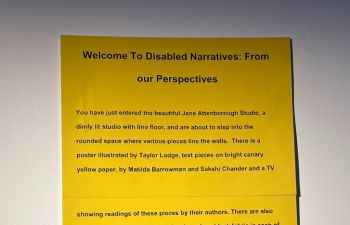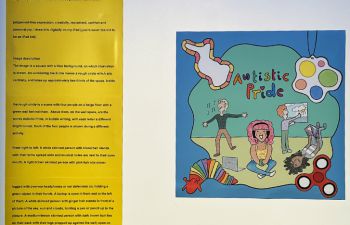Learn more about life at Sussex. For students, by students.
Disabled Narratives: a space to feel, not just see
Posted on behalf of: Sijal Sapkota
Last updated: Tuesday, 6 May 2025

I didn’t expect to feel so much — but I did.
On April 10th, I spent just over an hour at the Disabled Narratives: From Our Perspectives exhibition at the Jane Attenborough Studio. It was part of Sussex’s Festival of Ideas. I thought I’d just pop in for a bit, take a few notes, maybe grab a couple of photos. But I walked out feeling quietly emotional — with a full heart and a lot to think about.
Stepping into the space
As soon as I walked in, the atmosphere felt calm. The lighting was soft, the sounds gentle — it made you slow down. I didn’t feel like I had to rush around and look at everything. Instead, I felt like the space was inviting me to just be there and take it in.
The exhibition, curated by Sussex student Matilda Barrowman, featured work from three artists: Matilda herself, Saakshi Chander, and Taylor Lodge. Each shared something different, but together their work created something that felt really honest, thoughtful, and deeply human.
There were beanbags, tactile poetry, braille, and fidget toys. These details weren’t just for show — they made the space feel genuinely inclusive, designed with care and intention.

Matilda’s words moved the room
Matilda’s poem Neuromagorgia offered a powerful glimpse into her experience as someone who is cerebral palsic and autistic. Even when she wasn’t speaking, her words carried weight.
“To them, walking is a corridor. To me, it’s a trapped door that opens into a spiral…”
Her poem pushed back against assumptions — especially the idea that needing help means you’re not independent:
“You are forcing incompetence, assuming you know more than me because of your mild authority.”
Her performance wasn’t just something to hear — it was something to feel.
Saakshi’s story felt familiar
Saakshi’s piece really stayed with me. They spoke about drama being a safe space where they could express themselves, and I immediately thought of my own school drama classes — one of the few places I felt like I could fully be myself.
They talked openly about anxiety, identity, and learning to see their disability as part of who they are, rather than something to hide.
“I stopped feeling my disability as a weakness.”
“We have stories to tell too. We deserve to be valued.”
They also spoke about a teacher who encouraged them to step out of their comfort zone — someone who really saw them. That kind of support made all the difference. It wasn’t just about being on stage — it was about being seen.
“Pajoma,” they said — a Swahili word for inclusive — wasn’t just a play. It was a space where they finally felt represented.
Taylor spoke joy into the room
Taylor’s piece, Autistic Pride, was full of softness and colour. It showed neurodivergent people dancing, painting, resting, stimming — just being. What really brought it to life was the audio description.
“Each of the four people is shown doing a different activity that helps them feel relaxed and joyful...
This piece is about judgement-free creativity, movement, comfort and personal joy.”
I closed my eyes while listening. Taylor’s voice was warm and steady. It reminded me that accessibility isn’t just about seeing or hearing — it’s about being made to feel welcome.

Letting it all sink in
At one point, I sat on a beanbag with a fidget toy in my hand and just breathed. It’s rare to be in a space where it feels okay to feel things deeply. I wasn’t worried about how I looked or what I was doing — I was just there, in the moment.
The honesty in that room was powerful. It wasn’t dramatic or loud — it was quiet, and it was real.
What I took away
We don’t often get chances to really listen like this — to slow down and hear what it’s like to move through the world differently.
“All big social and political changes start with giving voices a platform.” — Matilda Barrowman
That’s exactly what this exhibition did. It created a space for people to share their stories — and it did so with care and respect.
I visited during the general viewing between 3 and 4pm, and I got to chat with Ifrah, the Digital Media Creator who was filming that day. She asked me what I thought, and I said:
“This was a very eye-opening experience — certainly one must feel through visiting this exhibition with a clear mind.”
And I still stand by that.
The exhibition was produced by Lauren Church, with Grace Merry assisting, and brought to life by a brilliant creative team. Lia and Taylor captured the experience beautifully through photography and communications.
Every voice in that room had something real to say — and it was heard. Fully, honestly, and with heart.
Spaces like this remind us that storytelling isn’t just about being included — it’s about being truly seen.
Sijal is a final-year Geography with International Development student at Sussex
